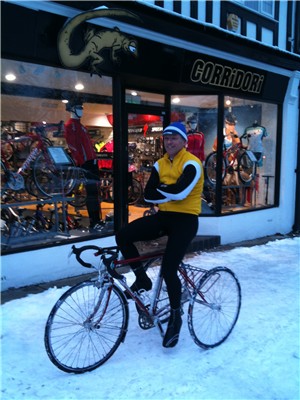
Layering is good; no doubt about it. This does not mean, however, that any old layer will do or that they can be put on in any old order.
Before choosing a system of layers, it is worth reflecting on what they are each supposed to do. The innermost is intended to keep the skin as dry as possible and is arguably the most important in terms of fibre. Since the coefficient of thermal conductivity of water is about 25 times that of air, it is better to have air than water filling the spaces between fibres if you are looking for effective insulation.
The body
Cotton does the opposite and is next to useless, especially as a base layer, for the hard effort of cycling since it holds on to a lot of moisture. Probably the best fibre is polypropylene, which rejects water and wicks it quickly away from the skin to whatever garment is outside it.
This middle layer performs two functions: it has to trap insulating air and, in turn, carry moisture away from the base layer so it does not become saturated. Wool is widely held to be the best choice for the body but there is wool and wool. Some types, such as Merino, can be woven into a much finer, thinner fabric than others, which is fine for warmer weather but not necessarily for real cold, since less air is trapped in the thickness of the fabric. For freezing weather I favour a low-rent old grey lambswool pullover from Next complete with moth-holes; cheap, unseen in use and very effective.
Wool’s other advantage is that it can hold several times its own weight in water without feeling wet; in other words, a moderate amount of moisture held between the fibres does not impair insulation. This is useful because there is inevitably a transit time between moisture leaving the base layer and arriving at the outer layer, where it needs to be able to evaporate.
This is where opinions as to the best solution really differ. Is it better to have a wind-proof shell that prevents cold air penetrating the fabric and displacing warm air or to allow some air to pass through the various layers in order to remove perspiration? In cold and wet weather, the answer is obvious; wear a waterproof shell and put up with excess warm moisture inside or you will get soaked and chilled by cold water from the outside.
In cold, dry weather, I prefer to stay drier and cooler and, rather than pull on a wind-proof shell, wear a plain knitted polyester or similar road jersey. This is not least because cooling airflow means I can go harder on hills without overheating and, since on a bunch ride I have to ‘go hard’ or at least put a lot of effort in to stay in touch on hills, this ensures I don’t get too hot.
In any case, getting damp under a shell is a recipe for disaster in the event of having to stop for, say, a puncture. The moment you stop generating body heat, you start getting cold very quickly as the moisture conducts warmth away from the body core. Take the shell off in a cafe and you cool quickly as the moisture evaporates from the base layer.
The legs
A long-time fan of bib-knicks, I accept that they are not adequate for proper cold. They do, however, pair up to perfection with bib-tights, doing the same job as shorts but with extra insulation where it is needed over the thigh muscles and knees.
Feet
Warm socks are a must, of course. So, too, are overshoes. However, my best results this year have been achieved by pulling a pair of Prendas Oversocks over my shoes and then donning a pair of Pro Endure overshoes over the top. This traps that all-important layer of air between shoes and overshoes while preventing cold air from chilling the feet. If this sounds like it contradicts the advice given on covering the body, remember that feet don’t sweat much in the winter.
Hands
Thick gloves, obviously. However, it is easy to overlook the importance of covering the wrists. Warm arterial blood travelling to the hands passes close to the skin here and, if the skin is exposed to cold air, valuable heat is lost before it gets to them. Of course, uncovering the wrists is a useful way to lose excess heat.
Head
Ideally I’d have a shell of some sort over my thick knitted Etxe-Ondo ski-type hat to trap air… In fact, a road cap worn under the hat does the job of keeping wind blast off the temples and forehead. The peak, of course, keeps snowflakes out of the eyes.





